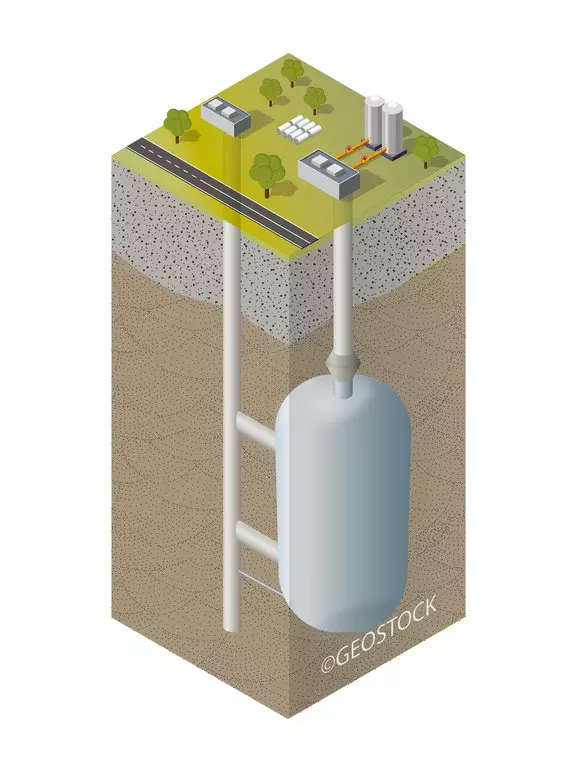Air Liquide – Hydrogen – an innovative partnership to develop underground storage.
Geostock and Air Liquide’s partnership is ambitious: the aim is to contribute to decarbonization, particularly that of industry and mobility. The use of hydrogen is one possible solution. It is therefore vital to develop the supply chain associated with this molecule, with a particular focus on its storage.
Replacing fossil fuels with decarbonized energies is one way of decarbonizing. Several solutions exist, including the production of renewable energy that will later be used (but that will also have to be stored in batteries) and the much larger-scale production of energy carriers that can be stored, such as hydrogen. Hydrogen can be used directly as an energy carrier or it can be stored before being reused to generate electricity via gas turbines (power to power).
One key solution is underground or geological storage, as
Jean-Claude Joyeux, Director of Hydrogen Solutions Development at Air Liquide, explains:
Today, hydrogen is stored on the surface in liquid or gaseous form and in limited quantities.
“We currently store around 150 tons of hydrogen per site; this can rise to 300 tons for gaseous hydrogen. When hydrogen production increases, we will need to store considerable quantities – thousands or even millions of tons – on various sites around the world. If surface storage were used, this would have a detrimental effect on agricultural, urban and industrial land. Underground storage is therefore the best option.”
Elodie Zausa, Development and Sales Manager at Geostock, agrees:
Underground solutions make it possible to store very large quantities of hydrogen.
“For example, a lined mined cavern, which is a gallery that has been excavated from natural rock by humans and then lined, can hold between 200 and 1,000 tons of hydrogen. Between 5,000 and 10,000 tons can be stored in a salt cavern and even more can be stored in a porous medium, bearing in mind that a single site may comprise several caverns, depending on the geology, which will also determine the technique to be used.”
Storing hydrogen in lined caverns
Elodie Zausa explains:
There are several types of underground energy storage: salt caverns, mined caverns, porous media (depleted hydrocarbon fields or aquifers). Hydrogen is already stored in salt caverns and Air Liquide has operated one of these caverns in the United States since 2017. “Saline caverns are a solution worth considering, because the technology is the most tried-and-tested and the most cost-effective,”
“We prioritize this approach wherever possible, but it requires the presence of salt formations, something that isn’t necessarily present in all regions. A salt cavern is created by washing away a layer of salt (by injecting water via a borehole into the salt formation to dissolve it and create a cavity). In general, a salt cavern is between 500 and 2,000 meters below the surface and has a volume of several hundred thousand cubic meters.”
To meet the growing need for hydrogen storage, other solutions need to be explored. The partnership between Geostock and Air Liquide is focused on storage in lined mined caverns, a technological solution that can be developed in areas where there is no salt.
Elodie Zausa adds:
“To be able to store hydrogen gas in large quantities, it must be stored at high pressure. However, in mined caverns, which are only a few dozen meters deep, the maximum acceptable pressure is just a few bars (hydrodynamic containment). A liner must therefore be applied to ensure that the storage is watertight. Resistance to pressure is provided by the rock itself; this varies, depending on how hard it is, etc.” Granite and limestone hard rock are the best options and make it possible to reach a pressure of at least 150 to 200 bars.
Jean-Claude Joyeux explains:
“When the rock has been excavated, a layer of concrete is laid to smooth the rock and allow the liner to be fitted, ensuring that the cavern is watertight. Our partnership brings together Geostock’s expertise in underground storage and Air Liquide’s expertise in a range of hydrogen-compatible materials.”
A safe and innovative solution
Underground storage has numerous advantages, beginning with its small carbon footprint and potential economies of scale. The safety of this solution, which presents minimal risks, is also a real plus, as Jean-Claude Joyeux points out,
“Hydrogen is the lightest gas in the universe. To be used efficiently, it needs to be liquefied or compressed. When gases are stored under high pressure, the main risk is that the container in which they are stored might explode. When stored at a depth of 200 meters in an underground cavern, it’s conceivable that the gas will escape, but there’s no risk of explosion.”
Elodie Zausa says:
Another advantage lies in the potential locations of underground storage. “Underground storage facilities can be installed almost anywhere,”
“In the absence of salt formations, the alternative for storing massive quantities of hydrogen is either porous media or lined mined caverns.”
Although there are many advantages, underground storage does have a drawback, namely the volume of rock that must be recycled after excavation. But Elodie Zausa remains positive: “In some locations, we already have customers interested in using these rocks to build roads, reinforce dykes and more!”
A number of projects are currently being analyzed and the first is due to be launched in 2026. Once the design and authorization phase has been completed, building work for the project will take three to four years. Through this partnership, Air Liquide will be able to access a large-scale storage solution for hydrogen and an alternative to saline storage.
Elodie Zausa concludes:
“We share the technical and financial risks of developing this technology. As partners, we aim to go faster and further together, optimize costs and make this technology accessible as soon as possible,”
In the years to come, the development of these new storage solutions will prove increasingly crucial, in view of the growing demand for hydrogen. In response to this, Air Liquide plans to increase its production capacity to reach 3 GW by 2030.
READ the latest news shaping the hydrogen market at Hydrogen Central
Air Liquide – Hydrogen – an innovative partnership to develop underground storage. source









